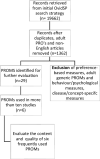Measuring What Matters for Children: A Systematic Review of Frequently Used Pediatric Generic PRO Instruments
- PMID: 34142363
- PMCID: PMC8332594
- DOI: 10.1007/s43441-021-00311-x
Measuring What Matters for Children: A Systematic Review of Frequently Used Pediatric Generic PRO Instruments
Abstract
Objective: To provide an assessment of the quality of the most frequently used self-reported, generic patient-reported outcome measures (PROMs) that measure health-related quality of life (HRQoL) in children against the good research practices recommended by ISPOR task force for the pediatric population.
Method: Literature search was conducted on OvidSP database to identify the generic pediatric PROMs used in published clinical studies. The quality of PROMs used in more than ten clinical studies were descriptively evaluated against the ISPOR task force's good research practices.
Results: Six PROMs were evaluated, namely Pediatric Quality-of-Life inventory 4.0 (PedsQL), Child Health Questionnaire (CHQ), KIDSCREEN, KINDL, DISABKIDS and Child Health and Illness Profile (CHIP). All PROMs, except KIDSCREEN, had versions for different age ranges. Domains of physical, social, emotional health and school activities were common across all the instruments, while domains of family activities, parent relations, independence, and self-esteem were not present in all. Children's input was sought during the development process of PROMs. Likert scales were used in all the instruments, supplemented with faces (smileys) in instruments for children under 8 years. KIDSCREEN and DISABKIDS were developed in a European collaboration project considering the cross-cultural impact during development.
Conclusion: The comparison of the instruments highlights differences in the versions for different pediatric age groups. None of the PROMs fulfill all the good research practices recommended by the ISPOR task force. Further research is needed to define which age-appropriate domains are important for older children and adolescents.
Keywords: Adolescents; Children; Health-related quality of life; ISPOR; Patient-reported outcomes; Pediatrics.
© 2021. The Author(s).
Conflict of interest statement
TA, NA, CN, KK and FP are full time employees of Novartis. CN, KK, and FP have Novartis stock(s)/stock options. The views and opinions expressed in this article are those of the authors and do not necessarily represent the views of Novartis.
Figures
References
-
- Cieza A, Stucki G. The international classification of functioning disability and health: its development process and content validity. Eur J Phys Rehabil Med. 2008;44(3):303–313. - PubMed
Publication types
MeSH terms
LinkOut - more resources
Full Text Sources


